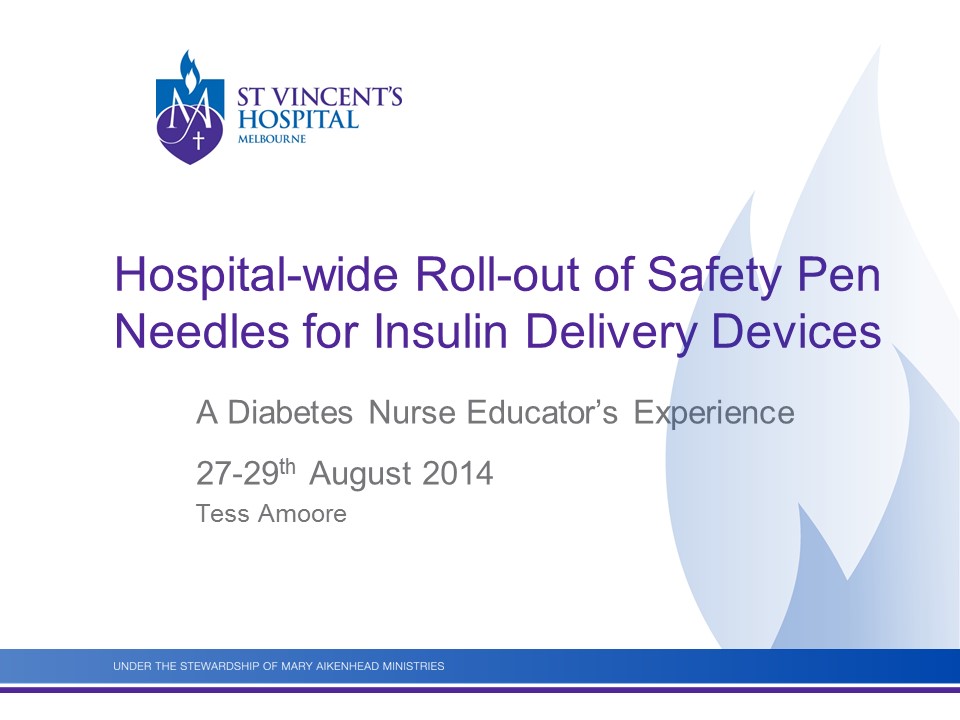Already a member? Click here to login.

Australian Diabetes Educators Association
Already a member? Click here to login.

Already a member? Click here to login.
Tess Amoore1, Richard MacIsaac1, 2, Kathleen Steele1
1. St. Vincent’s Hospital, Fitzroy, VIC, Australia
2. Department of Medicine, The University of Melbourne, Parkville, Victoria, Australia
 Hospital Wide Roll-out of Safety Pen Needles for Insulin Delivery Devices – A new Diabetes nurse educator’s experience
Hospital Wide Roll-out of Safety Pen Needles for Insulin Delivery Devices – A new Diabetes nurse educator’s experience
As a recently qualified Diabetes Nurse Educator working towards Credentialling, I want to share my successful implementation of a hospital wide change of practice.
Needle stick injuries (NSI) to Healthcare Workers (HCW) resulting from patients’ own pen delivery devices have six times the incidence rate compared with disposable syringes; placing significant human and financial burdens for the nurses involved and Health services as a whole1. The US and European Union governments have mandated the use of Safety Engineered Devices (SED’s) through guidelines, regulations and policy; this is yet to occur in Australia2.
To successfully implement a change management initiative and hospital wide roll-out of an insulin safety pen needle.
Hospital wide education and roll-out of a safety needle for insulin pen devices was successfully implemented following a collaborative approach. Evaluation of safety needle use is ongoing via monitoring of risk reporting.
1. Pellissier, G., Migueres, B., Tarantola, A., Abiteboul, D., Lolom, I., Bouvet, E., the GERES Group. (2006) Risk of needlestick injuries by injection pens. Journal of Hospital Infection 63, 60-64.
2. Murphy, C.L.The serious and ongoing issue of needlestick in Australian healthcare settings. Collegian (2013), http://dx.doi.org/10.1016/j.colegin.2013.06.003
Tess Amoore1, Richard MacIsaac1, 2, Kathleen Steele1
1. St. Vincent’s Hospital, Fitzroy, VIC, Australia
2. Department of Medicine, The University of Melbourne, Parkville, Victoria, Australia
 Hospital Wide Roll-out of Safety Pen Needles for Insulin Delivery Devices – A new Diabetes nurse educator’s experience
Hospital Wide Roll-out of Safety Pen Needles for Insulin Delivery Devices – A new Diabetes nurse educator’s experience
As a recently qualified Diabetes Nurse Educator working towards Credentialling, I want to share my successful implementation of a hospital wide change of practice.
Needle stick injuries (NSI) to Healthcare Workers (HCW) resulting from patients’ own pen delivery devices have six times the incidence rate compared with disposable syringes; placing significant human and financial burdens for the nurses involved and Health services as a whole1. The US and European Union governments have mandated the use of Safety Engineered Devices (SED’s) through guidelines, regulations and policy; this is yet to occur in Australia2.
To successfully implement a change management initiative and hospital wide roll-out of an insulin safety pen needle.
Hospital wide education and roll-out of a safety needle for insulin pen devices was successfully implemented following a collaborative approach. Evaluation of safety needle use is ongoing via monitoring of risk reporting.
1. Pellissier, G., Migueres, B., Tarantola, A., Abiteboul, D., Lolom, I., Bouvet, E., the GERES Group. (2006) Risk of needlestick injuries by injection pens. Journal of Hospital Infection 63, 60-64.
2. Murphy, C.L.The serious and ongoing issue of needlestick in Australian healthcare settings. Collegian (2013), http://dx.doi.org/10.1016/j.colegin.2013.06.003